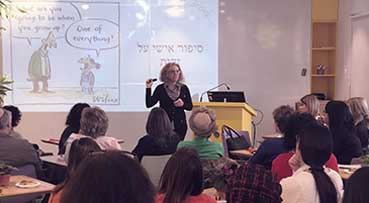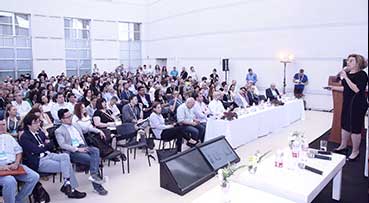If you’ve been reading my posts you already know I am passionate about the future of work, how it transforms the workplace and careers in the workplace. Last week’s post Managers in the Human Economy received a lot of great comments. One very interesting question came as a reader put together the conversation on employee engagement with a previous post on Portfolio Careers and asked me whether we can expect employee engagement from those working in a portfolio career. Or in other words, is it even realistic to expect someone working in a part time capacity, salaried or as self-employed or via an outsourcing organization to be engaged with the organization?
That’s a great question and we should address it from both sides of the partnership: that of the portfolio worker and that of the organization.
I had the privilege this week to experience a Keynote by Carla Harris, Vice Chairman, Global Wealth Management, Managing Director and Senior Client Advisor at Morgan Stanley. Carla shared a few of what she calls Carla’s pearls for successful careers. That is where I first heard the reference to our job as the “chair” and the organization we work in as the “house”. Our engagement at work happens at both those level, that of our role and that of our organization. And in both cases we should be able to answer the question “why am I here”?
At the job level, the best place to be, our career best, happens where our skills intersect with our interests. Or, in other words, if you’re good at what you do and you love it too. Working in this space, we don’t simply pass the time at work, waiting for the day to end so that we can go do what we love. We love what we do. If you’re at your career best, you know the answer to the “why am I here” at the level of your job. You’re here because you’re good at it and you love it.
That could, however not be sufficient for long term engagement. Our “chair”, our job, is within a “house”, our organization. That is the second element affecting our engagement.
Once we’ve answered the question why we do a certain job, we have to be able to answer the question why we work in this specific organization. One of the leaders I was privileged to work for used to say: “every day I come to work, I trade a day of my life. That better be worth it…” For many of us, being “worth it” includes working in an organization which embodies our values, where we can be proud of our belonging, where we are part of something we consider important and meaningful.
In a fascinating conversation with Dan Arieli he shared a story of an organization which makes operating systems for high end equipment. The engineering accomplishment of this product was very significant, yet its highly skilled engineers were not engaged and not motivated. Why? Because the nature of their product was so technical and so far from the end user, that they were not able to verbalize to people outside their organization what they were about. This inability to “speak” of the accomplishments and the successes impacted morale, motivation and engagement. In contrast, Arieli gave the example of Google where even those whose role is advertising could talk about their job with a company designing driverless cars. In the latter case, the impact of the “house” on engagement was larger even than the impact of the “chair”. Ultimately, beyond our skills and interests, we want to work on something meaningful in an organization we can connect to. And we want to be able to talk about both on Friday night with our friends and feel proud.
So back to the question, can we expect those not working as regular full time employees to be engaged?
If you are at your career best and doing so in a place you can connect to, does it matter if you’re a freelancer? If this company is not your employer but your customer?
Both the salaried employee as well as the self employed, project-based freelancer ultimately have a role in the organization, a “chair” and a “house”.
Portfolio career freelancers have more flexibility. They can choose the jobs they want, connect between the projects they choose and their skills and interests. If you have a portfolio career you are creating your professional brand and should ultimately be able to choose also where you want to work based on your passion and alignment with values and purpose. The companies you work for are not your employers, they are your customers. And while early on you might work for whoever is willing to pay for your services, as you build your brand and your skills you should be able to work where you choose.
Utopia? Maybe, but a career portfolio allows you to mix and match your projects in a way that suits your needs and passions. And even if some of your projects are not at your sweet spot, you can complement that in other aspects of your portfolio. A portfolio career today allows one more flexibility than that of a salaried employee in tailoring your work to your skills and interests. Therefore, there is no reason to assume someone working this way should be in any was less engaged than a regular full time employee.
And what role should the organizations play, in ensuring the engagement of the full range of the talent at their disposal?
As we learn to access talent in multiple ways, organizations will have to learn to engage not only their regular employees but also the rest of the talent working for them – their suppliers, service providers, freelancers, consultants and vendors. The Deloitte 2015 Global Human Capital Trends report addresses this head on:
“Today’s workforce is no longer a set of employees who come into the office or factory each morning or shift and go home each night. More and more of the workforce is composed of contingent employees working variable, often part-time hours or schedules, compensated hourly, operating remotely, or actually working for an external firm.”
In many countries employment laws still require that we strictly separate salaried employees from those operating through vendors or as self employed professionals. As a result, HR and managers today do not have a full view of the talent in the organization. This will have to change as more and more variability is introduced in the access to talent. Organizations will soon need to consider the various people working within them as an integral part of the workforce, regardless of their contingent or full-time status.

![large-AX1A2125-2[1] large-AX1A2125-2[1]](https://niritcohen.com/wp-content/uploads/elementor/thumbs/large-AX1A2125-21-pnzedcs72atx5aeurqytqdiihxixlq02re9mlz805s.jpg)






